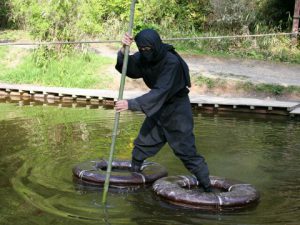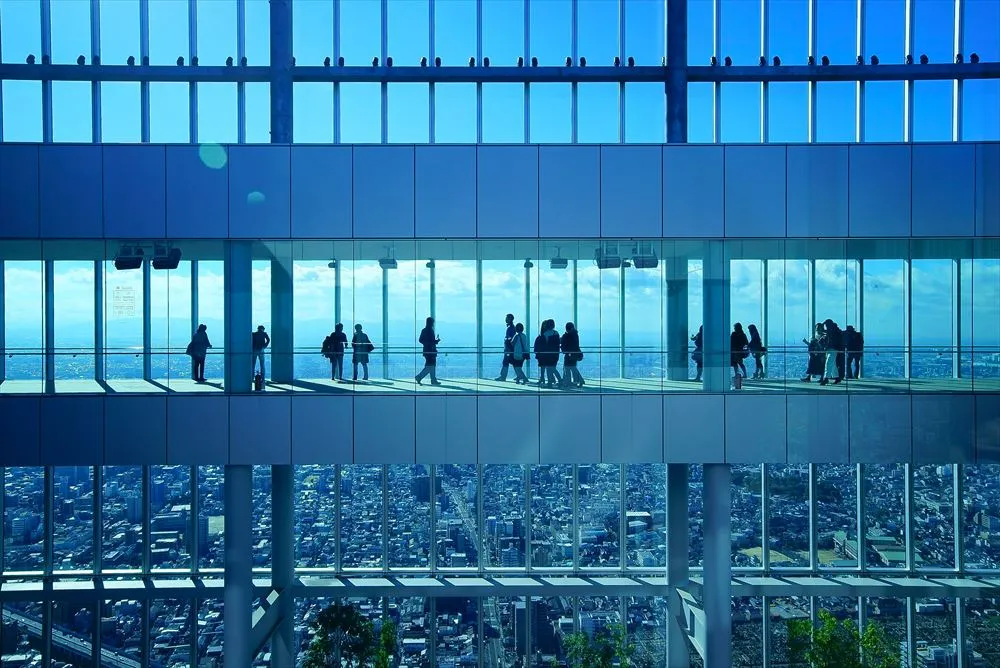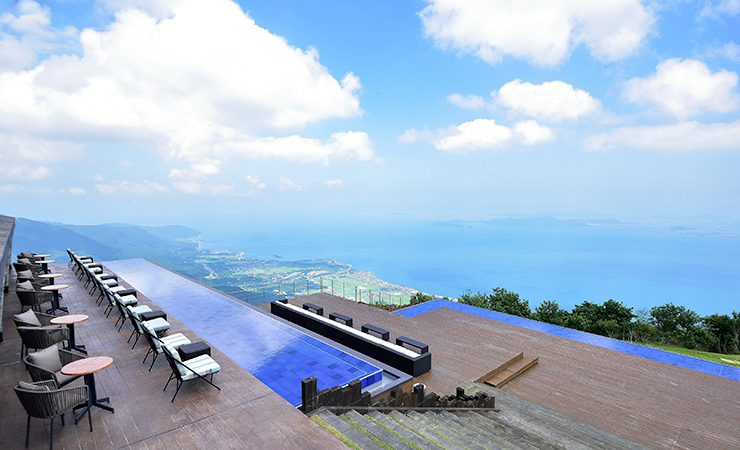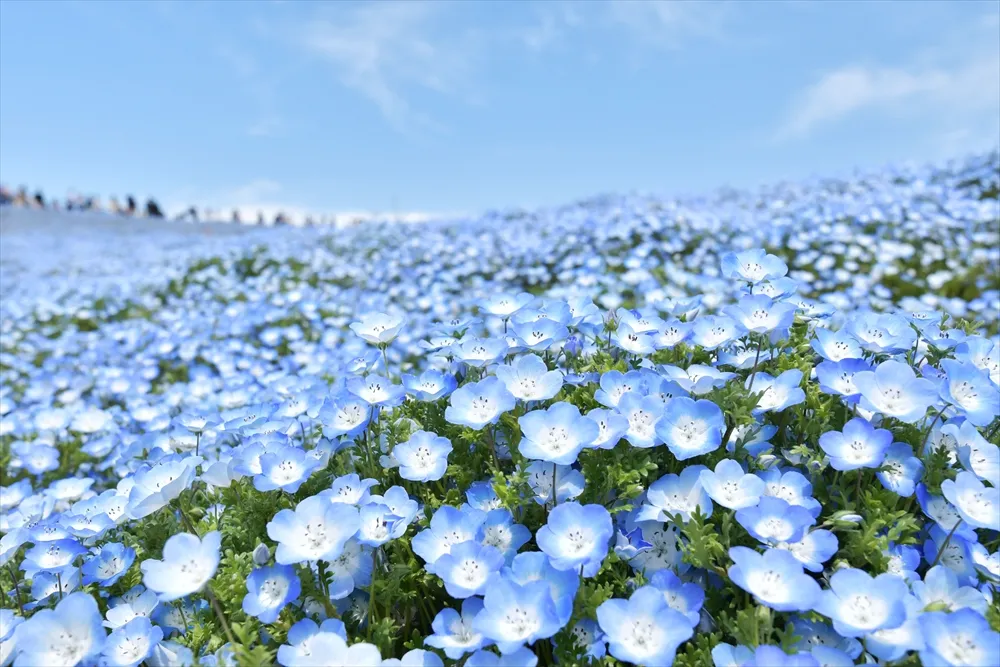
SHIGA (ATT.JAPAN ISSUE 47)
SHIGA (ATT.JAPAN ISSUE 47)
Shiga Prefecture holds the largest lake in Japan, Lake Biwa. This area is also called Omi Province, as this is how it was once known, and has been a strategic point connecting to Hokuriku, Tokai, and Kinai regions. From ancient times a good many people have come and gone and during the warring states period (the 15th to 16th century), it was said that he who controls Omi commands the world.
During the Edo Period (1603-1867), the circuits connecting Kyoto and Edo, the Tokaido and the Nakasendo; the Hokkoku Kaido leading to Echizen; the Western Omi Road going north along the west bank of Lake Biwa and leading to Tsuruga; the Shiotsu Kaido linking Tsuruga and Kohoku Shiotsu; the Wakasa Kaido (Saba Kaido), which created for the purpose of carrying marine products harvested from Wakasa Bay from the Middle Ages to the capital; and other routes as well were maintained to display the prosperous activity in each and every post station along these roads.
It is because of the remaining streets and towns painted in so much tradition and history that still even today all of the areas of Omi are overflowing with varied highlighted places of interest. These places include the UNESCO World Heritage site at Mt. Hiei and wonderful national treasures of Japan such as: Hikone Castle, original and creative museums, and ninja village, just to name a few. The Kohoku and Kosei regions have an abundance of nature remaining from the ancient times and, in the colder months, the beautiful snow-covered winterscapes become a paradise for migratory birds like the tundra swan.
Well then, without delay, let’s take a little journey through Shiga.
Otsu
It is only 10km (6.2 miles) from Kyoto to Otsu, the southeast region of Lake Biwa. Since ancient times even aristocrats have enjoyed the natural beauty of the four seasons of this lake country. With many merchants and post stations, each place has taken in the various cultures of those who passed through thus creating a very unique and open atmosphere.
Rising 848m (2,782 feet) high above sea level on the border between Kyoto and Shiga stands Mt. Hiei. From up near the summit you have an extraordinary view on either side with Lake Biwa on the one and Kyoto city on the other. The mountain mostly belongs to the Enryaku-ji Temple.
Mt. Hiei Enryaku-ji Temple was founded on the mountain top by a man named Saicho about 1,200 years ago and is divided into 3 large areas: Todo, Saito, and Yokawa. Todo is the main area with the Konponchudo Temple, a national treasure, as well as the Daikodo auditorium and other important temple buildings. The oldest structure within the grounds is Shakado and can be found in the Saito area. Yokawa is an area rich in nature and is where Shinran, Nichiren, and other noted monks carried out their pursuits of knowledge. This whole temple is registered as a UNESCO World Heritage site and there is a shuttle bus that loops through the complex should you get tired of walking.
If you decide to spend the night at the Enryakuji Kaikan assembly hall, you will be able to join in the 6:30am morning prayers. Within the eastern base region of the mountain is Sakamoto, a prosperous town originally built around Enryaku-ji. There is a beautiful, solid rock wall called “Anoshu-zumi”, of which similar style walls can be seen at other places such as Shigainmonzeki and Hiyoshi Taisha Shrine.
There are a great many venerable ancient temples in Shiga Prefecture. For example, Mii-dera (Enjou-ji) was established in year 686. On the extensive grounds you will find the national treasure Kondo Main Hall which itself houses over 100 national treasures and other important cultural property. Another temple, Ishiyama-dera, is said to have been founded in year 761, and has served as a popular pilgrimage destination from long ago seeing visits from a good many pilgrims. The most famous of visitors, Murasaki Shikibu, author of the Tale of Genji, often visited this temple and is said to have worked out the plot for her story there. Along with the national treasures of the Tahoto two-storied pagoda and Hondo main hall, there are a number of other national treasures and pieces of important cultural property as well. All over the temple grounds you can see the oddly shaped Wollostonite rocks protruding from the mountain, which is how the temple name was derived (ishiyama means “rock mountain” in Japanese).
Koto – East side of Lake Biwa
Omi Hachiman is a castle town that was created in the mid-19th century and, as a key point for economic and distribution markets, sent out many Omi merchants into the world to promote and continue its prosperity. Former residences of wealthy merchants from the Edo Period, the former residence of American architect William Merrell Vories as the Vories Commemorative Museum as well as other Western style architecture from the early Meiji Period (1868-1812), and many other great examples in architecture still remain in this area. White-walled earthen storehouses and old prestigious houses line the canal waterways and the Hachiman-bori Moat. You can tour this waterfront community on a “suigo meguri” boat with one of the 4 companies currently running tours on motorized as well as non-motorized vessels.
Within the peaceful rural area of Gokasho, another Omi merchant town, you can see white-walled and plank board fenced merchant mansions all lined up. The Nakae Jungoro residence, Tonomura Uhee residence, and Tonomura Shigeru residences were built adjacent to each other and you can buy a combined pass to see all three of the merchant homes. A huge lake sits in the middle of the very large garden in the Fujii Hikoshiro residence and there is a path to follow to view the area. Inside the Western style house, the personal collection of Western furniture and miscellaneous articles of Mr. Fujii are on display.
In the past, Hikone prospered as a castle town but is now known for its national treasure, Hikone Castle. Then again, nowadays focus tends to be on “Hikonyan.” This character mascot (a personified cat wearing a samurai helmet) was created in 2007 to usher in the 400th year anniversary of the castle, but has since then taken Japan by storm, becoming the most popular yuru-kyara (this type of institution-created character for marketing purposes) in the country. If you are lucky, you just might run into “Hikonyan” and its performance in front of the castle tower.
Centuries ago, as the top of fudai daimyo that were in hereditary vassalage to the Tokugawa house, many successive generations of feudal lords from the Ii family served as Shogunate Chief Ministers. On the outside, Hikone Castle remains today just as it was back in the Edo Period and is one of only four preserved castles designated as national treasures (the other three being Inuyama Castle, Aichi, Himeji Castle Hyogo, and Matsumoto Castle, Nagano). On the south side of Hikone Castle you can find Yume Kyobashi Castle Road, a redesigned street where the buildings look like those from the original castle town with white walls, blackened gable roofs, and black latticework. Nearby Yonbancho Square is a shopping area with stores and houses recreated in an attractive gas-lamp lit Taisho-era style.
In 1937 the school building and auditorium of Toyosato Elementary School in Toyosato-cho town was first commissioned to be designed by Vories, then constructed, and finally donated all by Furukawa Tetsujiro, a graduate of the school himself who had gone on to become the managing director of Ito-Chuubee-Shoten (which would be the predecessor of the Itochu Corporation and Marubeni Corporation). A majestic structure back in those days, it is still definitely worth taking a look at and, as a matter of fact, on May 30, 2009, it was given a fresh new start as the town’s facilities for education and welfare.

In Koka, at the southern tip of Shiga Prefecture, is one of the two main ninja areas, the famous School of Koga ninja village. Iga City of neighboring Mie Prefecture, the second main area, was the birthplace of the School of Iga ninjutsu and both areas once had a large number of ninja houses. At these facilities, it is considered that while ninja performed their daily training, they served the daimyo and feudal lords through acts like stealth surveillance and assassination. Here at Koga Ninja Village you can adorn the garb of the ninja and experience ninja training for yourself. You can also try the different hidden mechanisms in the houses, things like hidden doors, pull-down staircases, and other stuff from scenes you have read in comics and seen on television.
The western part of Koka City is Shigaraki, known for its ceramic and porcelain wares, especially the tanuki raccoon dog. The Miho Museum with its ancient works of art is a famous art museum also in this area. The museum, designed by the same designer of the Louvre pyramid, I. M. Pei, was made to feel like an ancient sacred temple. Integrated into the surrounding landscape and buried in the thick mist of the deep mountain valleys, this mostly underground piece of art in itself attracts numerous visitors from foreign countries as well.
Another museum built well incorporated into the surrounding mountain landscape is the Sagawa Art Museum. In the image of Itsukushima Shrine in Miyajima, this modern building feels as though it is floating on a water garden. The modern tea house was created in 2007 and is definitely worth visiting. The tea house is open every week on Thursday, Friday, Saturday, Sunday, and national holidays (except for the first and third Friday of each month when it is closed) but advanced reservation is always required. These reservations can be made by telephone only, at least one month in advance.
Kohoku – North side of Lake Biwa
With grand dreams the warring state military commanders faced off on this land. Reminders of this are all over the place as in scarred battlefields where the fate of the whole land was influenced or in the various temples remembered in connection with the warring daimyo feudal lords. However, around the skirt of the mountain the peaceful country expands out and is dotted with villages that lie unaffected by the strife.
The first territory Hashiba Hideyoshi (later known as Toyotomi Hideyoshi) received from Lord Nobunaga was Nagahama. With the construction of Nagahama Castle and the policy of free markets and open guilds, commerce started to develop. At one time the castle was abandoned in the Edo Period but the influence of Nagahama continued as a post station and as a hub for trade and commerce. The old black-walled houses remaining along the Hokkoku Kaido are currently getting a second life as a shopping district called Kurokabe Square, which means “black wall” square in Japanese. One such shop makes use of a former bank building constructed in 1900, the Kurokabe Glass Museum, where glass products are on display and for sale. There are various other shops as well, such as the Hikiyama Museum (floats used in festivals) and the Kaiyodo Figure Museum (toy figures).
Floating on the water in the very center of Lake Biwa is an island with a circumference of 2km (1.24 miles) called Chikubushima. If you climb all 165 steps of the rock staircase, you will find Tsukubusuma Shrine (Chikubushima Shrine) and Hogon-ji Temple built as if they were clinging to the slanting surface of the mountain. For a very long time this temple has gained the faith of many travelers as an important stop on the 33-site Saigoku (Western Japan) Kannon Pilgrimage and is counted as one of the 8 most beautiful scenes of Lake Biwa.
At one time, a distinctive Buddhist culture flourished in Kohoku with Mt. Kodakami, a mountain 923m (3,028 feet) above sea level, at its center. Outlasting the many wars and political turmoil, many images of Buddha are still remaining on the mountain. These pieces have never been taken from this location by religious groups or temples because local residents through the generations have wanted to protect and pass the precious pieces down to future generations just where they stand. There are, however, a number of pieces with a connection to Mt. Kodakami enshrined at Kokoukaku and Yoshirokaku in Kinomoto-cho.
Images of the Bodhisattva of Compassion (eleven-faced Kannon) in Kohoku are portrayed in novels by Inoue Yasushi (1907-1991) and by Mizukami Tsutomu (1919-2004). Particularly known is one created in year 736 and kept by the Kogen-ji (Dogan-ji) Temple in Takatsuki-cho town. This statue, adorned with earrings and having the body slightly turned at the waist, conveys the style and manner of India and western China. It is said to be the most beautiful image of the eleven-faced Kannon out of the 7 national treasures of its kind within Japan and loved so much that even back when all temples were on the verge of being wiped out during the warring states period, village people buried their beloved Bodhisattva in the earth to protect it, saving it from destruction.
The eleven-faced Kannon image at the Nishino Yakushi Kannon-do is from the early Heian Period (the 8th-12th century). A solemn, steady sense of comfort can be seen in this statue with the chubbiness of the body, notably the chest and thighs. As for the eleven-faced Kannon image at Shakudo-ji Temple, even now some of the red coloring remains on the lips and makes for a very elegant face. Both statues are designated as important cultural property.
Old houses still remain lining the streets in the prosperous Hokkoku Kaido post station of Kinomoto. Joshin-ji Temple (Kinomoto Jizo-in) is said to offer the grace of healing for those with eye problems and there are many other interesting places to see as well in the town.
It may be a good idea to make use of the rental bicycles and go around touring the various Buddhist statues. You can drop the bicycle off at the station nearest you anywhere within the northern Lake Biwa area and maybe even enjoy some hiking. If you are in this area during the autumn season, the different colors of all the changing leaves is really quite a sight. Speaking of beautiful sights, you can take a cable car up to near the top of Mt. Shizugatake for a full panoramic view of Lake Biwa. Historically, an important battle just after the death of Oda Nobunaga, the Battle of Shizugatake, was fought in this area in 1583 as Toyotomi Hideyoshi and Shibata Katsuie (1522?-1583) vied for supremacy.
Sekigahara, formerly part of the Nakasendo, is now an essential point for the Shinkansen Bullet Train track to run through. In the year 1600, a decisive contest, the Battle of Sekigahara, was fought in this area with the winner, Tokugawa Ieyasu (a founding general of the Edo shogunate), finally grasping real control of the entire land. Today, blessed with pure water wells this area is abundant with nature and also has the highest peak in Shiga Prefecture, Mt. Ibuki at 1,377m (4,518 feet). In the mountains medicinal plants can be found and in the summer around the summit you can see the heavy growth of the alpine plants in fields of alpine flowers. You can also enjoy activities in nature, such as mountain climbing, paragliding, and skiing.
There are many locations of spring water known in Shiga Prefecture and Izumi Shrine is one of these. Many people go to draw water from this spring. Another, the Jizo River, is home to Ito fish and the green sturgeon, both of which can only survive in places with very clean water. This plentiful spring water is also being used to cultivate rainbow trout at the nearby Samegai Trout Farm.
Kosei- West side of Lake Biwa
A popular area for enjoying marine leisure and water sports is the unaffected bountiful nature at the foot of the Cordillera Hira on the west bank of Lake Biwa.
At an elevation of 1,100m (3,610 feet) above sea level, Biwako Valley is the foremost area for skiing in the Kansai region. There are hiking routes, outdoor leisure facilities, campgrounds, and other fun things set up to be enjoyed as well.
The Shirahige Shrine in Takashima is said to have longest history in Omi. In Harie region, the culture of water and water-usage called Kabata remains since a long time ago. The spring water is drawn into the house and into a pond on the premises with the cleanest water being used for drinking and cooking. The grains of rice stuck to the tableware after a meal are fed to carps in the ponds and after the water is purified it is flowed into the town’s river. Every year in early summer small white Baikamo flowers can be seen growing in the Harie-okawa River that flows through the middle of the town. Baikamo can only grow in water that is always clean and at a constant temperature throughout the year, so this is proof that Harie is indeed a town rich in water.
Kaizu has prospered as a post station and port town back from times long ago. Tile roof houses with beautiful latticework, shops that are generations old offering practically the only funazushi in Japan, sake breweries, and other relics remaining in this former post station.
Makino Pickland is a hands-on experience-style agricultural park. Cherries, chestnuts, grapes, and other fruit picking can be enjoyed here. There is also a private place that is rumored to resemble the popular Korean television drama “Winter Sonata.” In the middle of Makino Pickland, there is Metasequoia Avenue, which is a straight row of about 500 Metasequoia (Dawn Redwood) trees extending for 2.4km (1.5 miles).
Arihara is a village unchanged and traditional with lines of private homes with thatched roofs. During the winter season, this area sees heavy snowfall and the atmosphere becomes that of a completely secluded, unexplored region.
The Takashima Trail is a walk along the mountain ridge from Makino to Imazu and Kutsuki and spans about 80 km (50 miles). Recently, overhaul of the trail has been making progress. Hiking where you can have a great view of the Sea of Japan and Lake Biwa is very popular.
Column1 Lake Biwa
Ancient Lakes hold over some hundreds of thousands of years of history and there may be but only 10 in the world. Lake Biwa is one of these such lakes. About 80 different types of freshwater fish, half of the species found in all of Japan, inhabit this lake with more than 10 of those species being found only in Lake Biwa. Occupying an area of 1/6th Shiga Prefecture, the circumference of the lakeshore is around 235km (146 miles). There are luxury cruises from Otsu Harbor and high-speed boats connect all of the ports of Konan, the southern part of the lake. Water-quality study ecology cruises are becoming more and more popular and you can even enjoy various water sports as well.
Column2 Omi Merchants
In former Edo, if you said ‘merchant,’ you were talking about Omi merchants. These were men with a talent for business who would travel the whole country selling their wares and, with only a little bit of money for capital, would later set up shops in the large cities. As for corporations with roots going back to these Omi merchants, there are the trading companies like Marubeni and Itochu; the department stores Takashimaya and Daimaru; the spinning companies of Toyobo and Nisshinbo; and companies like Nissay, Seibu Group, Yanmar, Wacoal, and others who have come to be the examples representing Japan. Among the many wealthy merchants, most came from Gokasho, Hino, and Omi Hachiman, and many elegantly built homes and facilities of merchant families can still be seen in these towns.
Column3 The Culture of Stones
Omi is also famous for its many examples in the stone-carving arts. Even the written characters meaning ‘rock’ and ‘stone’ in Japanese are used in many of the place-names as well as in the names of temples and shrines. It is because the land in this area has always had superior stone carvings that talk of Omi as being the land of stone-material production had come about. In among the mountains there still remain gigantic pedestals made of rock upon which enormous sculptures once stood as well as stone huts from the varying-sized ancient burial mounds. A steep flight of naturally shaped rock stairs starts at the base of the Kannon-ji Mountain and continues all the way to the top. Up at the summit sits the ancient temple, the time-honored Kannonshouji Temple. Omi is also known for its many famous castles. Near the summit you will find the ruins of the main castle the Sasaki clan used in its 400-year long reign of Omi. The castle was destroyed by Oda Nobunaga (one of famous warlords, 1534-1582), but an undamaged stone wall still remains. Hikone Castle is the only castle in this area that still remains in its complete form but just by looking at the stone wall at the ruins of Azuchi Castle, one can conjure up an idea of what a magnificent site it must have been back in its day. Then there is Sakamoto at the base of Mt. Hiei, known as a town with beautiful stone walls remaining from days of yore.






